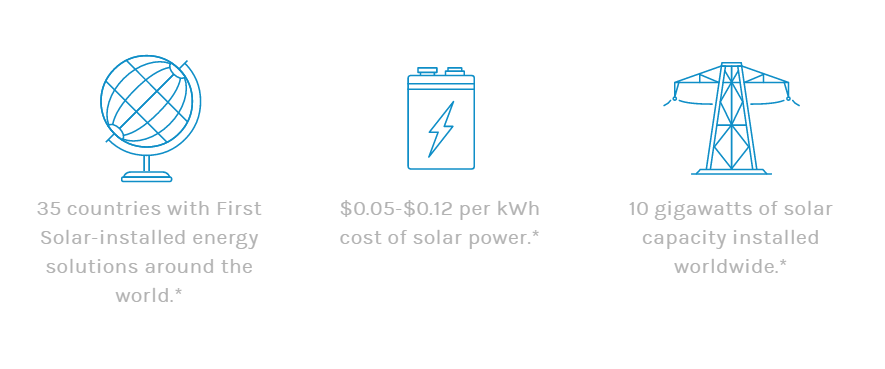Every quantum of sunlight takes eight minutes1 to travel 93 million miles2 before it becomes the first ray of someone’s sunrise, before the leaves of a maple tree use it to create sweet sap, and, thanks to First Solar, before millions of solar modules around the world convert sunlight into more than 10 gigawatts of clean, renewable energy.3
That’s enough to power seven million homes, displace nine million metric tons of CO2, and the equivalent of taking nearly two million cars off the road or planting around 240 million trees.3
Getting this far took more than eight minutes. First Solar has been driving solar energy forward since its founding in 1999, working to advance its goal of making solar power an affordable alternative to conventional energy. Their innovative solar modules use a thin film of highly conductive material that could be overlaid on glass, to mass-produce less expensive solar cells. Years of continuing research have increased the efficiency of its solar technology, so now First Solar can deliver more reliable and cost-effective solar energy solutions to the world.
Think about it: First Solar is developing technology to create clean, renewable power from the sun that is cost competitive with fossil fuels.**

First Solar had to advance more than just the technology to bring solar into the 21st century. Its business is evolving worldwide, enabling First Solar to become a global integrated solar power company able to manufacture panels and build out vast solar farms to deliver cost-effective renewable energy to utilities, independent power producers and consumers. Those arrays of photo-voltaic modules stretch across thousands of acres in 35 countries—from Thailand and India to Chile and big sunny tracts of desert in the U.S.4
"Years of continuing research have increased the efficiency of its solar technology, so now First Solar can deliver more reliable and cost-effective solar energy solutions to the world."
To become a leading energy solutions provider, First Solar needed access to the energy that powers markets: capital. The company has partnered with Morgan Stanley in a long-term relationship that extends beyond its $460 million initial public offering in 2006. When First Solar has required financial, market or strategic expertise, Morgan Stanley has been there to offer its advice, solutions and access to investors and capital—most recently, a $700 million revolving credit facility in 2015—that allow First Solar to continue to improve its technological and operational efficiencies and to reach even more markets.
Sunlight can still reach the 1.3 billion people in the world who live without access to electricity.4 First Solar wants to close that gap, offering solar-power-generating capabilities to new regions globally.
It’s not quite the speed of light, but in many of the darker places on earth, it’s a powerful beacon of what is possible.
Find a Financial Advisor to discuss your investment goals and strategy.
* Based on information from First Solar. For more information, please visit: www.firstsolar.com/About-Us/History# ** Based on information from First Solar. For more information, please visit: www.firstsolar.com/About-Us/Corporate-Responsibility/Environmental-Impact. 1 Based on data from NASA.gov. For more information, please visit: www.nasa.gov/missions/solarsystem/micro_probe.html. 2 Based on data from NASA.gov. For more information, please visit: www.nasa.gov/audience/foreducators/k-4/features/F_Measuring_the_Distance_Student_Pages.html. 3 Based on data from First Solar. For more information, please visit: www.firstsolar.com/en/About-Us/Resource-Library. 4 Based on data from First Solar. For more information, please visit: firstsolar.com/-/media/Documents/Sustainability/03801_FirstSolar_SustainabilityReport_08MAR16_Web.ashx. © 2016 Morgan Stanley & Co. LLC. Member SIPC. CRC 1527882 06/16.
:focal(990x167:991x168)/https://tf-cmsv2-smithsonianmag-media.s3.amazonaws.com/filer/63/17/6317a0cb-432d-4bcb-950d-943de182a2c1/header-image-morgan-stanley-energy-pink.jpg)